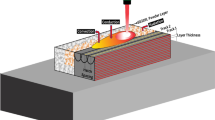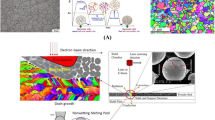Abstract
The quality of powder feedstock for additive manufacturing (AM) metal powder bed fusion methods can significantly affect the quality of parts built from it. Particle size distribution (PSD) and shape factors influence flowability as well as the thickness and uniformity of each powder layer in the build box. For high-performance applications such as aerospace, medical, power generation and military, it becomes important to identify critical additional factors: the types, numbers and sizes of particulate contaminants that may be present in the powder. This is true for virgin, used and blended powders. Contaminants may be introduced during powder manufacture (e.g., ceramic insulation fragments from gas atomization equipment), handling (building insulation, talc) or possibly during the build process itself. Contaminants contained within a batch of powder can be physically built into an additive part when they are incorporated into the melt pool, and they can remain as discrete particulates or non-fused interfaces that act as stress concentrators. Their presence may decrease fatigue life by increasing the likelihood of fatigue crack initiation. This article describes three methods to rapidly and quantifiably characterize powder feedstock. (1) Computer-controlled scanning electron microscopy (CCSEM) provides quantitative size and shape parameters, as well as fine surface details from individual images on a particle-by-particle basis in large populations of powder. (2) Energy-dispersive spectroscopy (EDS) can be included, providing insights into variations within a batch of powder, as well as contaminant compositions. (3) For critical applications, the heavy liquid separation (HLS) method physically extracts low-density contaminants from a sample of powder metal down to part-per-billion detection limits to allow direct examination of contaminants and enhance identification and prevention of their sources. Altogether, these methods permit direct comparisons among powder metal samples. Better quantification of powder characteristics aids determination of suitability for end uses.














Similar content being viewed by others
References
A. Simchi, The Role of Particle Size on the Laser Sintering of Iron Powder, Metall. Mater. Trans. B, 2004, 35(5), p 937–948
D. Manfredi, F. Calignano, M. Krishnan, R. Canali, E.P. Ambrosio, and E. Atzeni, From Powders to Dense Metal Parts: Characterization of a Commercial AlSiMg Alloy Processed through Direct Metal Laser Sintering, Materials, 2013, 6(3), p 856–869
E.O. Olakanmi, R.F. Cochrane, and K.W. Dalgarno, A Review on Selective Laser Sintering/Melting (SLS/SLM) of Aluminum Alloy Powders: Processing, Microstructure and Properties, Prog. Mater Sci., 2015, 74, p 401–477
J.A. Slotwinski, E.J. Garboczi, P.E. Stutzman, C.F. Ferraris, S.S. Watson, and M.A. Peltz, Characterization of Metal Powders Used for Additive Manufacturing, J. Res. Nat. Inst. Stand. Technol., 2014, 119, p 460–493
A.T. Sutton, C.S. Kriewall, M.C Leu, and J.W. Newkirk, Powders for additive manufacturing processes: characterization techniques and effects on part properties, in Solid Freeform Fabrication 2016: Proceedings of the 27 th Annual International Solid Freeform Symposium, 2016, p 1004–1030
P. Kantzos, P. Bonacuse, J. Telesman, T. Gabb, R. Barrie, and A. Banik, 2004, Effect of Powder Cleanliness on the Fatigue Behavior of Powder Metallurgy Ni-disk Alloy Udimet 720, Superalloys, p 409–417
ASTM F3001-14, Standard Specification for Additive Manufacturing Titanium-6 Aluminum-4 Vanadium ELI (Extra Low Interstitial) with Powder Bed Fusion, ASTM International 2017 Annual Book of ASTM Standards, vol. 10.04, p 838–843
G.S. Casuccio, P.B. Janocko, R.J. Lee, J.F. Kelly, S.L. Dattner, and J.S. Mgebroff, The Use of Computer Controlled Scanning Electron Microscopy in Environmental Studies, J. Air Pollut. Control Assoc., 1983, 33(10), p 937–943
A.J. Schwoeble, A.M. Dalley, B.C. Henderson, and G.S. Casuccio, Computer-Controlled SEM and Microimaging of Fine Particles, J. Met., 1988, 40, p 11
A.M. Dalley, S.K. Kennedy, and A. Ziegenfuss, The Use of Computer-Controlled Scanning Electron Microscopy for Powder Metal Characterization and Contamination Identification, SAE-RJ Lee Group White Paper (2018). https://saemobilus.sae.org/content/WP-0008/
P.G. Roth, J.C. Murray, J.E. Morra, and J.M. Hyzak, Heavy liquid separation: a reliable method to characterize inclusions in metal powder, in Characterization, Testing and Quality Control, Advances in Powder Metallurgy and Particulate Materials, vol 2, Comp. by Chaman Lall (Metal Powder Industries Federation, Princeton, 1994), p 1–12
F. Chayes, Petrographic Modal Analysis, Wiley, Hoboken, 1956
E. Bono, Additive Manufacturing of Metals, in Course Description, ASM International Short Course, Materials Science and Technology Conference, Pittsburgh, 2017
Acknowledgments
The authors gratefully acknowledge and remember the valuable, long-term contributions of co-author Mr. Gregory J. Kotyk of RJ Lee Group, who passed away unexpectedly during this manuscript preparation.
Author information
Authors and Affiliations
Corresponding author
Rights and permissions
About this article
Cite this article
Kennedy, S.K., Dalley, A.M. & Kotyk, G.J. Additive Manufacturing: Assessing Metal Powder Quality Through Characterizing Feedstock and Contaminants. J. of Materi Eng and Perform 28, 728–740 (2019). https://doi.org/10.1007/s11665-018-3841-5
Received:
Revised:
Published:
Issue Date:
DOI: https://doi.org/10.1007/s11665-018-3841-5




